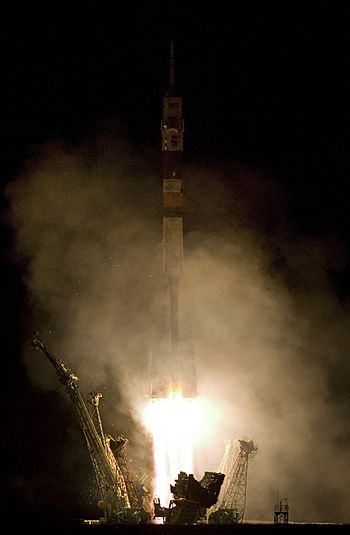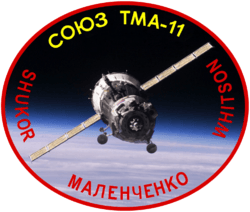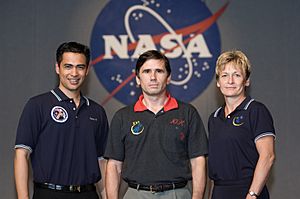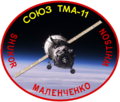Soyuz TMA-11 facts for kids
 |
|
| Operator | Roskosmos |
|---|---|
| Mission duration | 191 days, 19 hours, 17 minutes |
| Spacecraft properties | |
| Spacecraft type | Soyuz-TMA 11F732 |
| Manufacturer | RKK Energia |
| Crew | |
| Crew size | 3 |
| Members | Yuri Malenchenko Peggy A. Whitson |
| Launching | Sheikh Muszaphar Shukor |
| Landing | Yi So-Yeon |
| Start of mission | |
| Launch date | October 10, 2007, 13:22:39 UTC |
| Rocket | Soyuz-FG |
| Launch site | Baikonur 1/5 |
| End of mission | |
| Landing date | April 19, 2008, 08:30 UTC |
| Orbital parameters | |
| Reference system | Geocentric |
| Regime | Low Earth |
| Inclination | 51.6 degrees |
| Docking with ISS | |
| Docking port | Zarya |
| Docking date | 12 October 2007 14:50 UTC |
| Undocking date | 19 April 2008 05:06 UTC |
| Time docked | 189d 14h 16m |
  From left to right: Sheikh Muszaphar Shukor, Yuri Malenchenko, Peggy Whitson Soyuz programme
(Crewed missions) |
|
Soyuz TMA-11 was a space mission that took astronauts to and from the International Space Station (ISS). It launched on October 10, 2007, from the Baikonur Cosmodrome in Kazakhstan. The spacecraft carried two members of the Expedition 16 crew. It also took Sheikh Muszaphar Shukor, who was the first Malaysian in space.
Soyuz TMA-11 stayed at the ISS as an emergency escape craft. It returned to Earth safely on April 19, 2008. Even though it landed safely, there was a problem during its return. This caused it to land 475 kilometers (about 295 miles) away from its planned landing spot.
Contents
Meet the Crew of Soyuz TMA-11
| Position | Launching crew | Landing crew |
|---|---|---|
| Commander | Expedition 16 Fourth spaceflight |
|
| Flight Engineer | Expedition 16 Second spaceflight |
|
| Spaceflight Participant | Only spaceflight |
Only spaceflight |
Backup Crew Members
These astronauts were ready to fly if the main crew couldn't.
| Position | Launching crew | Landing crew |
|---|---|---|
| Commander | ||
| Flight Engineer | ||
| Spaceflight Participant | ||
Mission Highlights and Journey
The Soyuz TMA-11 spacecraft launched on October 10, 2007. It lifted off at 1:22 PM UTC. Officials said the launch went perfectly. In Malaysia, many people watched the launch live. They cheered in the capital city of Kuala Lumpur.
The Soyuz TMA-11 then traveled to the ISS. It successfully docked, or connected, with the space station. This happened on October 12, 2007, at 2:50 PM UTC.
A Bumpy Return to Earth
The spacecraft landed back on Earth on April 19, 2008. It landed in Kazakhstan. During its return, the Soyuz TMA-11 had a problem. It performed a "ballistic reentry." This means it came back into Earth's atmosphere at a steeper angle than usual.
Because of this, the spacecraft landed far from its target. It was 475 kilometers (about 295 miles) off course. This was not the first time a Soyuz spacecraft had this kind of problem. The crew members were recovered safely. However, the spacecraft's hatch and antenna were damaged from the heat.
Astronaut Yi So-yeon was taken to the hospital after landing. She had minor injuries to her neck and spine. These were caused by the rough landing.
Later, experts looked into why this happened. They found that one of five "pyro-bolts" failed. These bolts are supposed to separate parts of the spacecraft. The exact reason for the bolt failure was not fully known. However, being in space for a long time near the ISS might have damaged the firing system. A similar issue happened with the Soyuz 5 mission in 1969.
Images for kids
See also
 In Spanish: Soyuz TMA-11 para niños
In Spanish: Soyuz TMA-11 para niños





